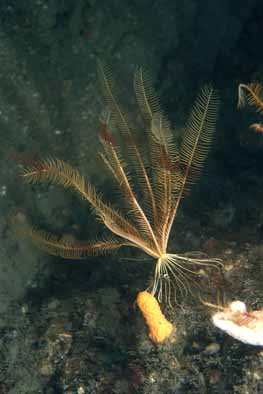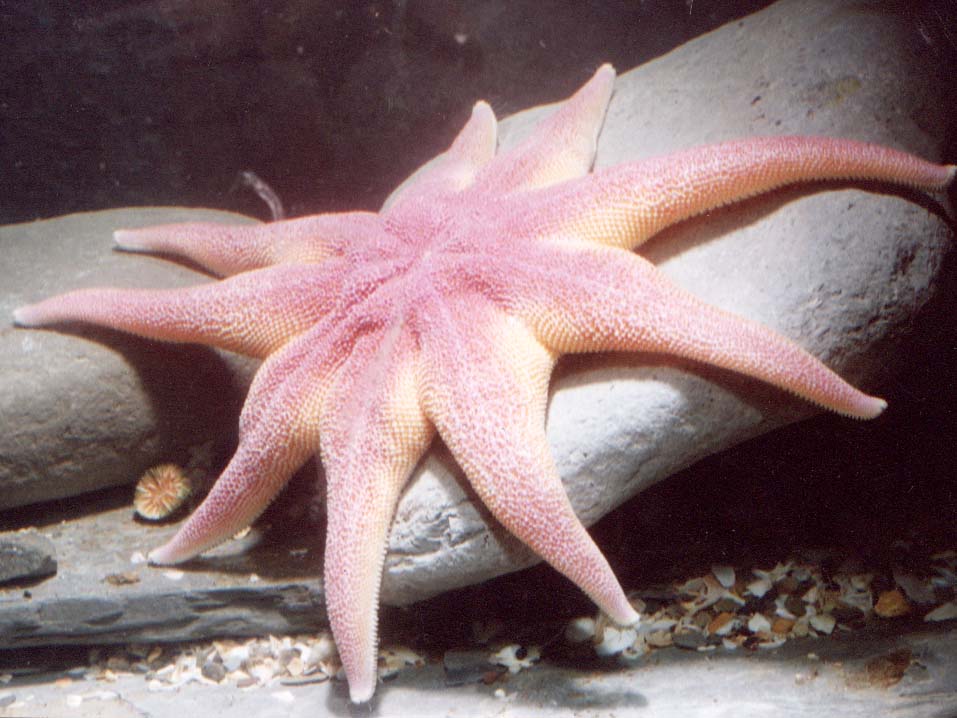 The
Common Starfish's Usual Size is up to 50 cm, tip of one arm to
another including the central disc.
The
Common Starfish's Usual Size is up to 50 cm, tip of one arm to
another including the central disc.Starfish
All information is from the Microsoft© Encarta 99© Encyclopedia
 The
Common Starfish's Usual Size is up to 50 cm, tip of one arm to
another including the central disc.
The
Common Starfish's Usual Size is up to 50 cm, tip of one arm to
another including the central disc.Starfish, or sea star, is the common name for 5 orders and about 1500 living species of marine invertebrate animals characterized by radially arranged arms with tube feet that allow them to move. Some starfish are only 0.4 to 0.8 inches wide as adults, but others are as much as 26 inches wide. The group is abundant at all depths of the ocean.
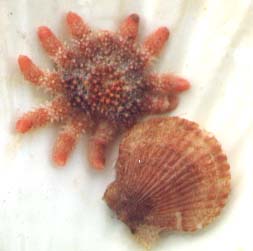 Generally
starfish are rather stiff bodied and crawl slowly. The mouth is
directed downward and is surrounded by a number of arms radiating
away from it, each arm bearing rows of tube feet used in crawling,
attachment, and feeding. The arm length varies, and four, six, or
more arms instead of the usual five are not uncommon. The anus is
often lacking; if present, it is on the body's upper surface. The
skin, rough and leathery, usually bears spines. The animal has a
large gut, a complex system of body cavities, and a simple, brainless
nervous system.
Generally
starfish are rather stiff bodied and crawl slowly. The mouth is
directed downward and is surrounded by a number of arms radiating
away from it, each arm bearing rows of tube feet used in crawling,
attachment, and feeding. The arm length varies, and four, six, or
more arms instead of the usual five are not uncommon. The anus is
often lacking; if present, it is on the body's upper surface. The
skin, rough and leathery, usually bears spines. The animal has a
large gut, a complex system of body cavities, and a simple, brainless
nervous system.
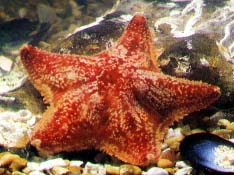 Starfish
have moderately well developed senses of touch, smell, and taste and
also respond to light. They feed on a wide range of items, including
ocean-bottom deposits. They can eat small animals whole; they deal
with larger prey by extruding their stomachs and digesting the prey
outside their bodies. Some starfish eat bivalves by prying open
the shells with their arms and then slipping their stomachs between
the two shell valves.
Starfish
have moderately well developed senses of touch, smell, and taste and
also respond to light. They feed on a wide range of items, including
ocean-bottom deposits. They can eat small animals whole; they deal
with larger prey by extruding their stomachs and digesting the prey
outside their bodies. Some starfish eat bivalves by prying open
the shells with their arms and then slipping their stomachs between
the two shell valves.
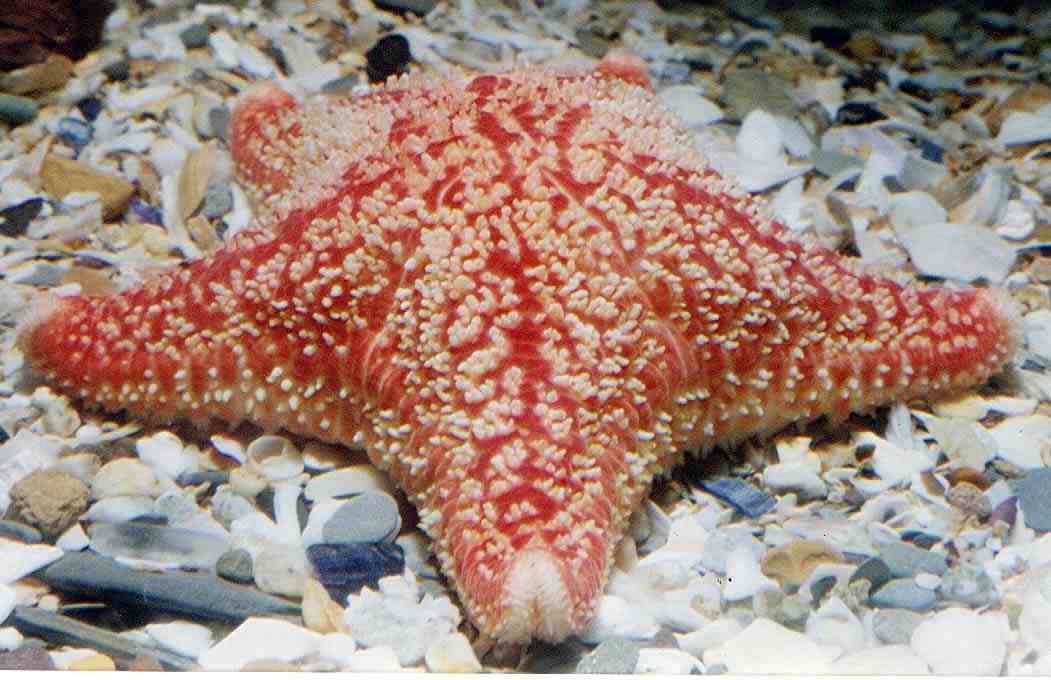 Most
starfish have separate sexes and spawn both sperm and eggs into the
water, where fertilization and early development occur. Sometimes the
mother retains the eggs on the bottom and protects them. Many
starfish have the power to regenerate body parts, and in some
starfish this becomes a regular means of asexual reproduction, new
animals being produced from each fragment.
Most
starfish have separate sexes and spawn both sperm and eggs into the
water, where fertilization and early development occur. Sometimes the
mother retains the eggs on the bottom and protects them. Many
starfish have the power to regenerate body parts, and in some
starfish this becomes a regular means of asexual reproduction, new
animals being produced from each fragment.
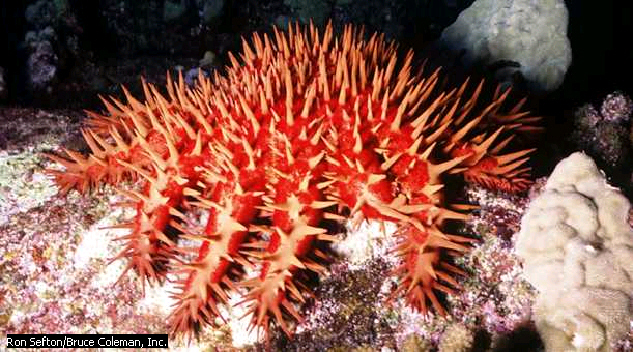 Starfish
play an important role in some animal communities, because they eat
a variety of materials and are often numerous. Under unusual
conditions they can do some harm: a few are pests of oyster beds, and
the crown-of-thorns starfish sometimes has population explosions that
damage coral reefs through overfeeding on the coral. Few animals
consume adult starfish, which are neither palatable nor nutritious.
Starfish
play an important role in some animal communities, because they eat
a variety of materials and are often numerous. Under unusual
conditions they can do some harm: a few are pests of oyster beds, and
the crown-of-thorns starfish sometimes has population explosions that
damage coral reefs through overfeeding on the coral. Few animals
consume adult starfish, which are neither palatable nor nutritious.
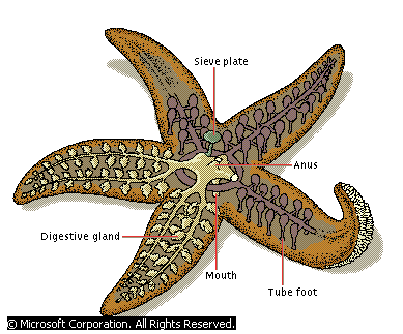
The starfish exhibits the internal hydraulic system particular to echinoderms. A central ring connects canals that run the length of each arm and branch into rows of tube feet. The hollow network, a modified body cavity, fills with water, creating a "skeleton" firm enough to walk on. By forcing water out through the tube feet, the starfish can extend and attach its suckers to a surface; by contracting the muscles at the base of the tube feet, it can move itself forward.
